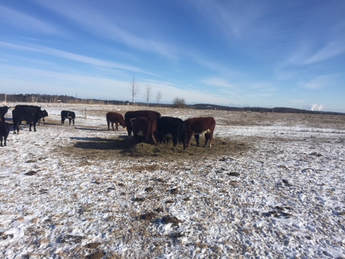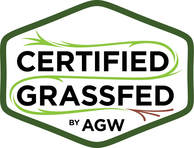 While it has felt rather “springlike” lately , we sure had a rough cold stretch here in the Midwest, starting our (official) winter season with sub zero temperatures. Many were asking me… What is winter like at the farm? Well, cold. But as far as our work and the cattle, this is what happens. Preparation In preparation for the winter, we cut and bale all our excess grasses in the summer in the form of hay for winter-feed. Also before winter hits, we give “pedicures” to all our older girls and donkeys, as we want them to have sure footing moving around in winter. We also pull out the bulls to tighten our calving season and have the cows give birth in spring/early summer on our green pastures, just as nature does it. Feeding During these months, while the cattle are still outside, once a week we set out bales of hay for a whole week out in the fields in different rows. Every day we open a fence with 4 to 5 big bales of hay in one row, cut them open and the cows move in to eat. We have “rows” like this and we move them with the electric fence. The cattle fertilizes the field with their droppings plus the wasted hay that falls out of their mouths feeds our soil life. They have access to water, salt, vitamins, minerals, sea kelp and if they so choose, shelter in the barnyard. Temperature The cattle prefer lower winter temperatures better than the real hot summer, but wind and cold rain are not a good combination, so while they are in pasture all year round, they do have access to the barns during the winter for shelter. Surprisingly to many, we rarely see them in! Our animals’ health is a concern during the winter, but our herd has been doing well as they get all the nutrition and energy they need during these cold months. The breeds of cattle we have (the English breeds) do well in our cold Midwest environment. The cattle grow a thick coat of hair that gets shed during the summer months. The calves have put on a fair amount of fat from the good milk their mothers produce, and the cows are doing well from the high quality hay they get over the winter. This layer of fat is great insulation, and is testament to our rich pastures. The Land All our grasses and plants go into hibernation. Each year we pick a different field to feed the cattle on over the winter. The field that the cattle stay on looks pretty beat up at the end of winter, but it comes back strong in the spring with all the fertility the cattle deposit during the winter months. It also gives our pastures more plant diversity as dormant seed get a chance to germinate with the open space made by the cattle’s foot activity. Other Every season there are repairs. Luckily, we only have had a few mishaps, one of the 2 water systems tripped a GFI breaker and we didn’t notice it soon enough and the system froze into a very large ice cube. The other 300-gallon tank that has a heater has performed well in this weather. Everything has been working quite smoothly this year, but we sure are looking forward to greener grasses and sunnier days!
3 Comments
Grazianos
1/23/2018 03:55:19 pm
Love the farm updates almost as much as we the love the beef we have been receiving the past months. Understand fully your wishes to move up to Wisconsin. Quality living will perfectly match your quality products.
Reply
Nancy Bley
1/23/2018 03:59:29 pm
Great information! Wish we were geographically
Reply
Your comment will be posted after it is approved.
Leave a Reply. |
AuthorMarisa usually writes about nutrition, grass fed beef, organic agriculture, as well as sharing delicious recipes; Paul writes about farm work- sharing his stories and experiences, and most times... we both collaborate on the stories! Archives
March 2024
Categories
All
|
 RSS Feed
RSS Feed


